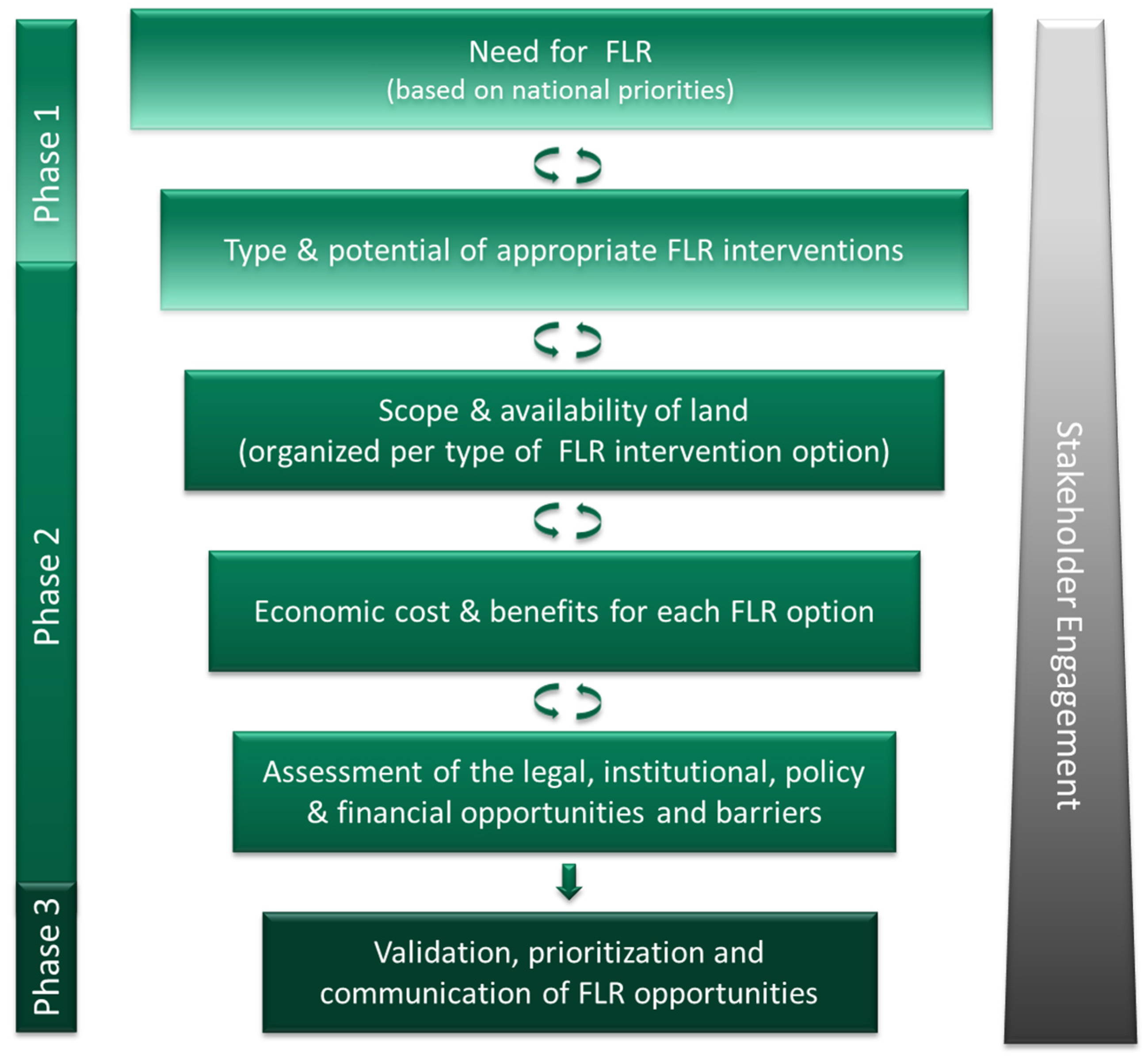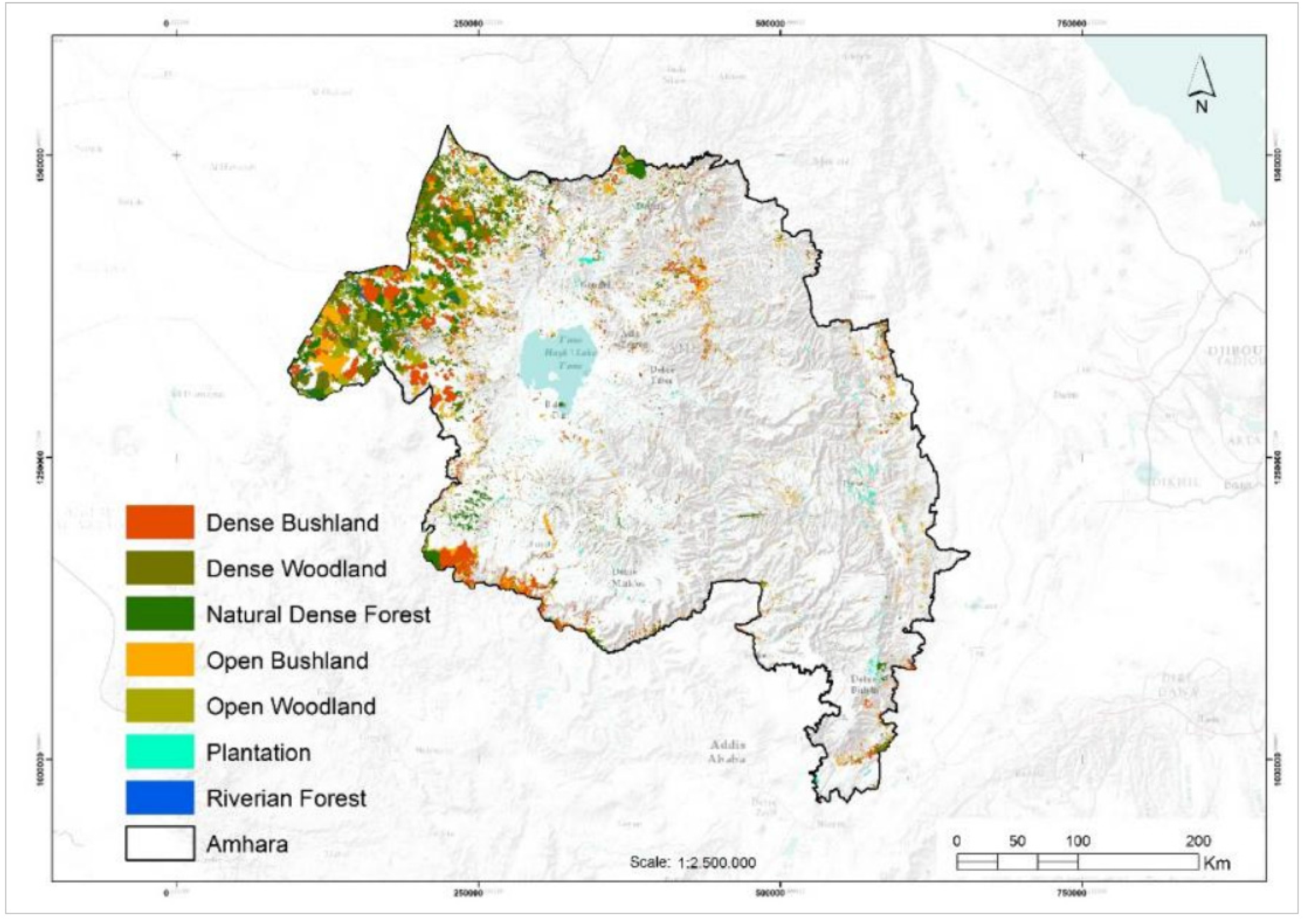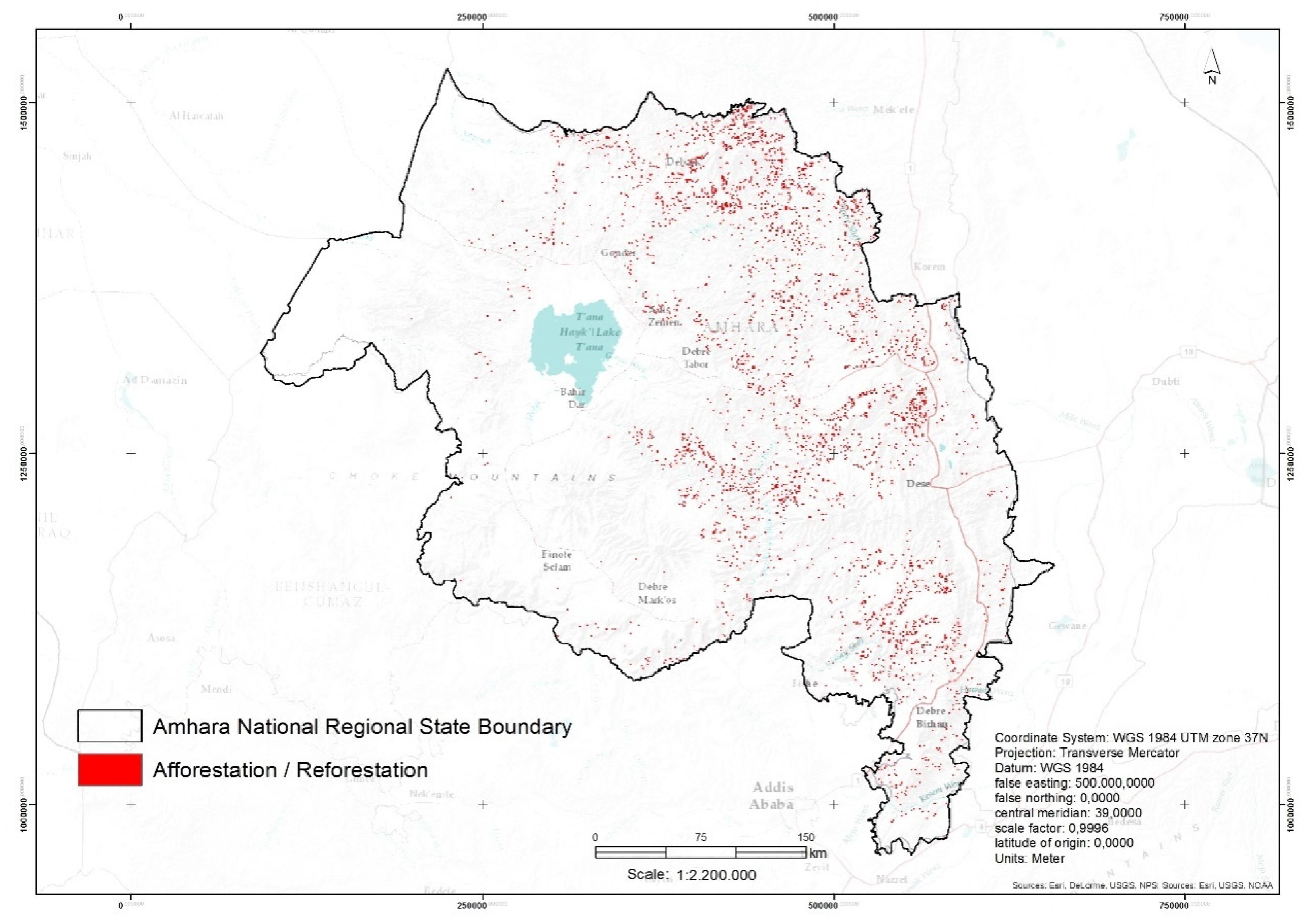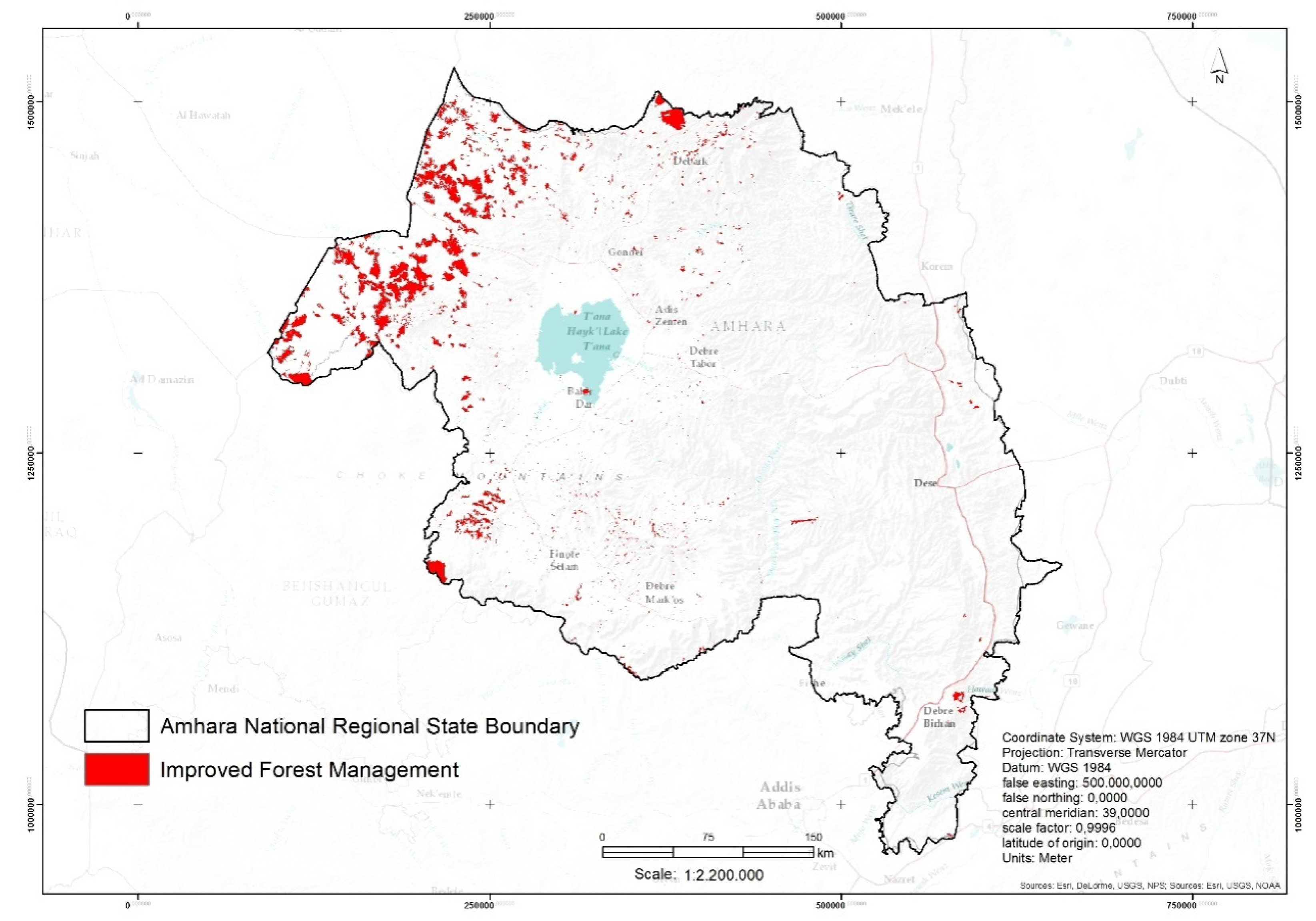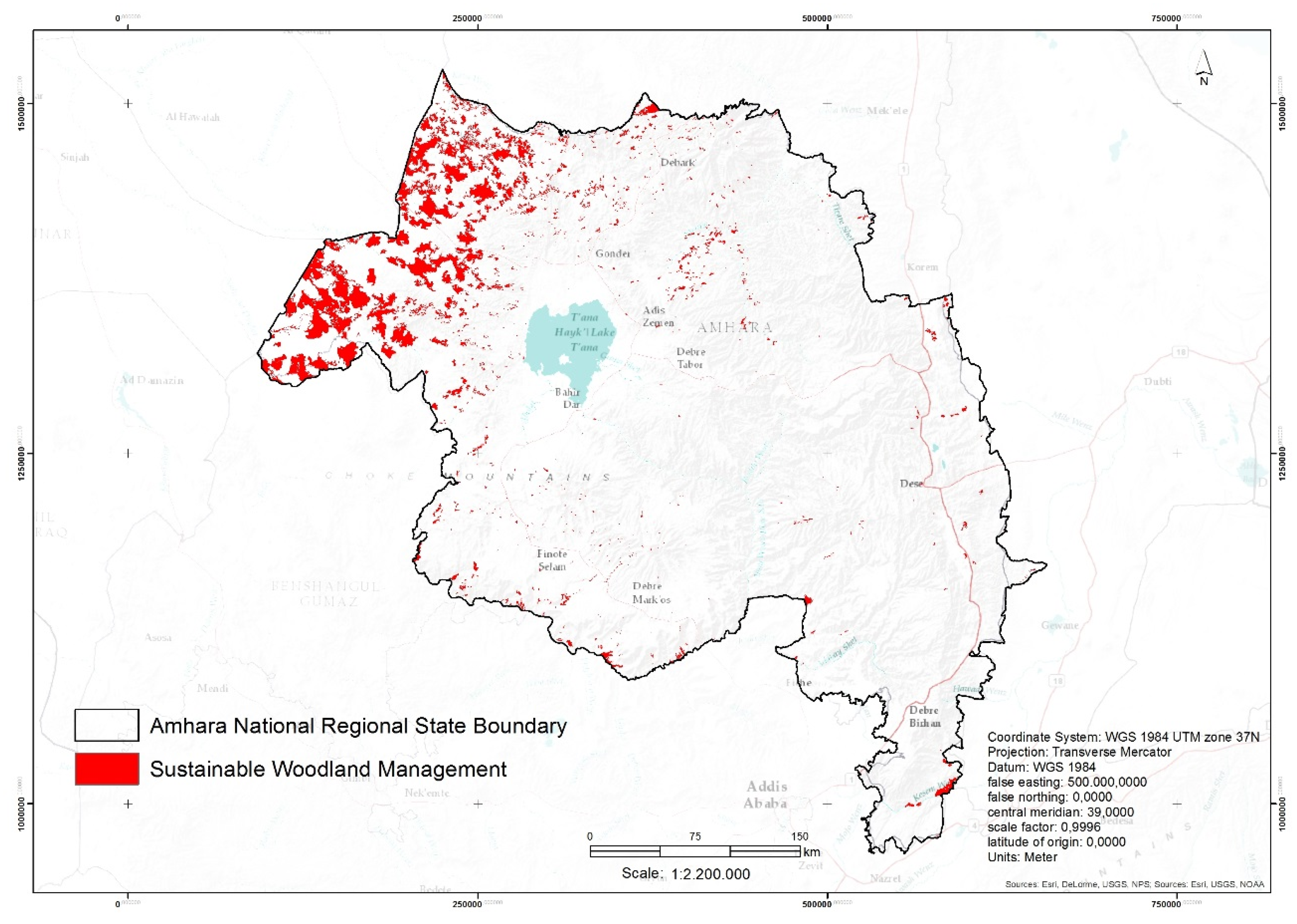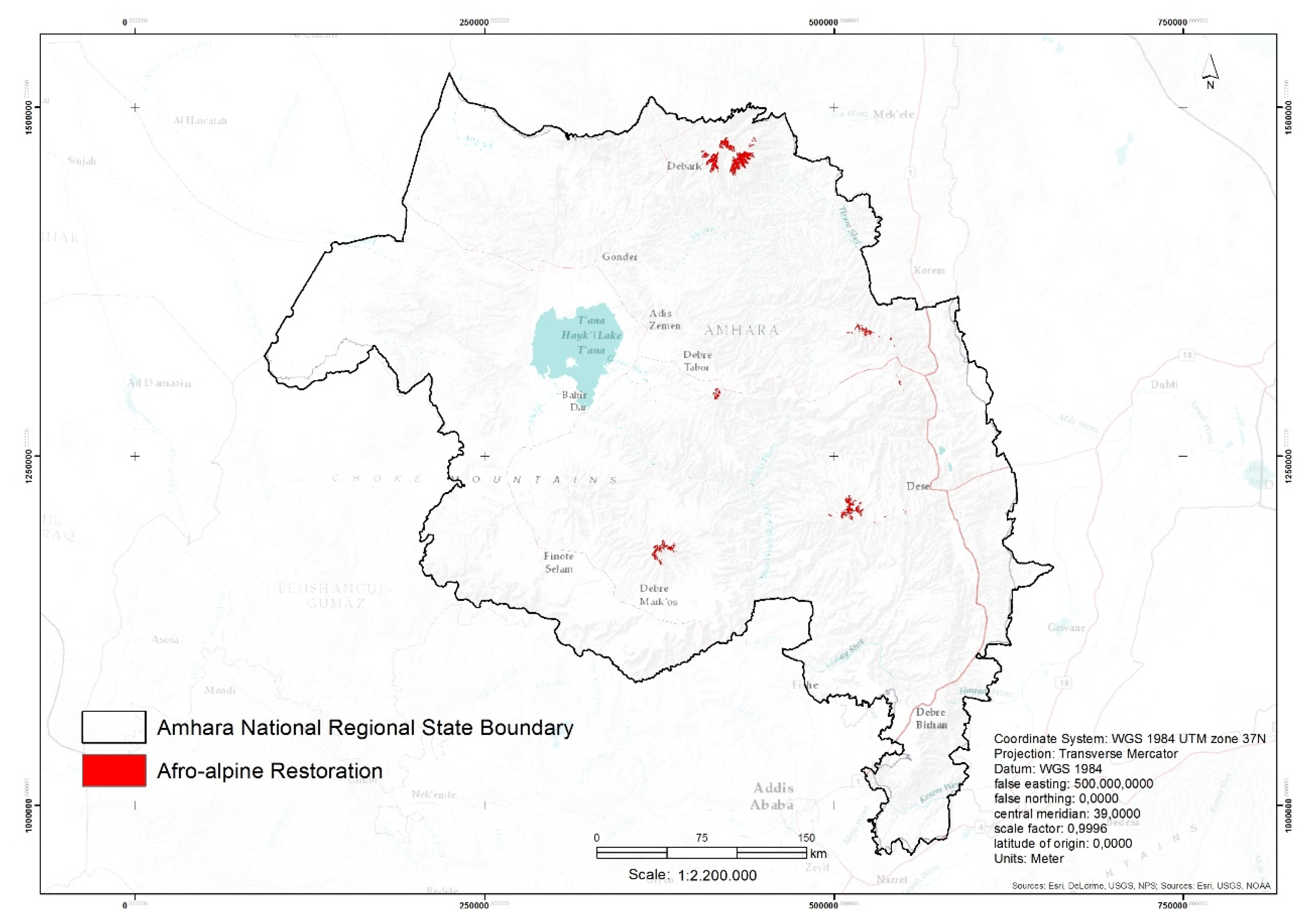1. Introduction
The global discourse on Forest Landscape Restoration (FLR) has its roots in the 1980s but only recently grew to a global movement. A milestone was in 2011 when the German government and the International Union for Conservation of Nature (IUCN) invited global leaders already engaged in the Global Partnership for Forest Landscape Restoration (GPFLR) to participate in the first Bonn Challenge [
1,
2]. The objective of this network is to foster implementation of internationally agreed policy objectives for the land use sector, in particular the Convention on Biological Diversity (CBD) Aichi target 15 and REDD+ (A mitigation approach for the land use sector negotiated in the context of the United nations Framework Convention on Climate Change; REDD+ stands for reduced emissions from deforestation and forest degradation, conservation of existing forest carbon stocks, sustainable forest management, and enhancement of forest carbon stocks.). On this basis, the Bonn Challenge was initiated as an informal high-level policy dialogue that sought to foster large-scale implementation on the ground. For this purpose, the participants declared at the first meeting the ambitious target of restoring 150 million ha of degraded forest landscapes by 2020 [
1] (as of November 2016 app. 124 M ha have been pledged [
3]). Given the relevance of FLR for aligning different environmental and development objectives and translating policies into action at scale, the target was further increased to 350 million ha by 2030 at the New York Climate summit in 2014 [
4].
Further momentum for FLR was created in 2015 through the second Bonn Challenge agreement on the Sustainable Development Agenda, which highlights integrated ecosystem and natural resources management as a core element of sustainable development, and the Paris Agreement under the United Nations Framework Convention on Climate Change (UNFCCC). Prior to the negotiations in Paris, the Parties to the UNFCCC submitted their Intended Nationally Determined Contributions, which in many cases highlight the importance of the forest and land use sector for mitigation of and adaptation to climate change.
The high-level policy dialogue on FLR intentionally takes place outside of formal negotiations because the non-formality of this governance approach allows for better tackling FLR as a cross-cutting issue and enables the inclusion of non-governmental actors [
5]. This is crucial for successful implementation, as existing sources of public funding will not suffice and significant private sector investments and proactive engagement are needed in light of the dimension of the objectives. Both the Bonn Challenge and New York Summit seek voluntary country and private FLR commitments, based on national circumstances and priorities for the land use sector. The rationale of this approach is that the high-level political will demonstrated by countries committing to FLR paves the way for private investments and public support at the national level as well as through bi- and multilateral channels of official development assistance (ODA). In order to pay heed to specific regional circumstances, the AFR100 Initiative was initiated, seeking to implement FLR on 100 M ha in committed African countries and constituting a key institution for the Bonn Challenge [
6].
Another aspect of this informal governance approach is the lack of agreed definitions, even for key terms such as “FLR” and “landscape.” Among the active discussants of the Bonn Challenge, it is generally agreed that FLR should follow an anthropocentric approach with a focus on restoration of ecosystem services. This implies an emphasis on enhancing benefits for human well-being through FLR—in contrast to “ecological restoration”—which is a more eco-centric concept that strives for achieving pre-disturbance states [
7] with subordinate considerations of costs and human needs [
1]. The broad approach leaves scope to committed countries and implementing agencies to choose from a wide range of activities [
8], but also bears potential conflicts regarding trade-offs and priorities [
9].
Which FLR transitions are appropriate depends on the contextual factors specific to the landscape. These include the nature and state of land and forest degradation, the pressures on the ecosystem, available resources for FLR, land development priorities of the government, the dependence of local people on natural resources for their livelihoods, and the density of the population [
9,
10]. Against this background, the attempt by the GPFLR to quantify the global FLR potential distinguishes between two main restoration types: (1) small-scale mosaic restoration, which is relevant in landscapes with dense population and a diversity of land uses, e.g., agriculture, agroforestry, silvo-pastoral systems of buffer plantings along rivers and settlements; and (2) large-scale restoration in areas where population density and land-use pressures are relatively low [
11].
Given the insufficient finance and high investment needs, FLR activities are ideally self-sustaining, in particular by promoting sustainable commodity value chains and corresponding business models to foster private sector investments. Where opportunities without viable business models arise, financing options will focus on public support, or monetizing the different ecosystem services they provide, e.g., through targeted payment schemes for environmental services. This is crucial as public finance will not be sufficient to implement FLR at scale [
1]. For piloting FLR, but especially for upscaling investments, it is necessary to address the enabling environment conditions and investment climate. This includes that authorities effectively address prevailing political, socio-economic, and environmental hurdles for FLR. More specifically, policy makers must provide functional legal frameworks, especially regarding tenure and land use rights, cross-sectoral coordination and land use planning, participatory processes, and benefit sharing systems to attract ODA support and private sector engagement.
For most countries, it is relatively easy to recognize the relevance of FLR and to make a respective pledge. However, translation into action on the ground reveals the need to simultaneously work at the policy level but also to assess specific opportunities and business models, in particular if successful implementation relies on significant private sector investments. In recent years, different tools have been developed to identify opportunities and challenges for countries with respective pledges. In particular, the restoration opportunity assessment methodology (ROAM) by IUCN and the World Resource Institute’s Landscape Restoration Diagnostic suggests analytical work, including through multi-stakeholder engagement, to support countries’ preparation for FLR implementation [
12,
13].
With the pledge to restore 15 M. ha of degraded and deforested lands by 2030, Ethiopia is one of the countries with the most ambitious FLR targets. This commitment aligns well with the aim of transitioning towards a Climate Resilient Green Economy (CRGE) with zero net greenhouse gas emissions and corresponding plans for large-scale afforestation and reforestation. Land and forest degradation are seen as key obstacles for development, linked closely with low agricultural productivity, food insecurity, and rural poverty. Approximately 85% of the Ethiopian population lives in rural areas and depends on rainfed subsistence agriculture for their food and income security. Estimates suggest 45% of the total Ethiopian land mass has been affected by soil erosion of arable land [
14]. Pressure on Ethiopian forests and drivers of land degradation are expansion of agricultural lands [
15], overgrazing and trampling by livestock [
16], and the demand for woodfuel (the source of 90% of Ethiopia’s energy requirements), as well as timber poles for construction [
17]. These anthropogenic pressures lead to increased erosion, loss of water resources, reduction in livestock production, soil nutrient depletion and degradation, and potentially desertification [
18], further exacerbated by the increasing effects of climate change.
The Government of Ethiopia in collaboration with its partner institutions is now pro-actively looking for how its ambitious national FLR pledge can be translated to on-the-ground action. The WRI has been supporting the Ministry of Forest, Environment, and Climate Change (MEFCC) to develop a national-level map that identifies where and what different FLR options can be implemented. Localized studies that take into account the needs and priorities of land users and communities are needed to complement these overview studies at the national level.
Against this background, the objective of this study is to conduct an in-depth assessment of FLR opportunities within one of Ethiopia’s national regional states. In collaboration with MEFCC and GIZ-Ethiopia, the study team selected the Amhara National Regional State (ANRS), a sizeable region of 16 million ha that is considered to house some of the most severely degraded landscapes of the country. Furthermore, ANRS has a highly dynamic and growing forestry sector, with public and private actors showing interest in small- and large-scale commercial forestry, including through outgrower schemes encouraged by the state-owned Amhara Forest Enterprise. Further, roughly 70% of Ethiopia’s smallholder woodlots established during the last two decades are located in ANRS [
19]. The study confirmed the significant potential for FLR and revealed promising opportunities for business models. After a brief description of the methodology (
Section 2), we present the results (
Section 3), discuss them against the background of Ethiopia’s socio-economic and political context (
Section 4) and ultimately provide short conclusions and an outlook on how to make FLR a reality in Ethiopia.
2. Materials and Methods
The study was carried out between May and September 2015. The research design consisted of five consecutive steps and followed to a large extent the analytical tools provided in the ROAM [
12]. The key success factors of the enabling environment was assessed through a qualitative approach based on interviews and available literature for each identified opportunity highlighted by Landscape Restoration Diagnostic [
13]: first, clear motivation and political will which is needed to catalyze the needed political and planning processes; secondly, that enabling conditions are generally favorable, including markets, policies, and institutions; and thirdly, sufficient capacities and resources to implement and invest into appropriate restoration opportunities.
The research approach was structured in three phases: scoping, analyses, and validation (
Figure 1). Active involvement of relevant authorities and stakeholders are seen as prerequisites for the transparency and legitimacy of the research process, ensuring the political connectivity that supports integrating the results in the political processes at different policy levels.
Different methods were used to collate the empirical information and discuss the findings with stakeholders. Analytical work included an extensive literature review, spatial data analyses, and field research carried out in two phases in 2015. The findings and the preliminary priority FLR options for ANRS were subsequently validated and further refined together with representatives of the Ethiopian government, development partners, and other local, regional and national stakeholders.
2.1. Background Analysis and Study Area Selection
Based on a review of Ethiopia’s institutional arrangements governing the forest and land use sector, ANRS was chosen in consultation with the MEFCC and GIZ-Ethiopia as a suitable study area. Reasons included the interest of both the national and regional government as well as the presence of promising elements for an enabling environment for FLR. For example, guidelines for participatory land use planning are legally recognized by regional Proclamation, (forest) land certification has advanced considerably, and the government and its partners provide incentives for tree planting. Previous studies point at a number of existing non-industrial plantations and woodlots in ANRS [
20], and the presence of one of Ethiopia’s two state-owned forest enterprises, which offer a functional structure for close collaboration with communities on or near the enterprise’s land. Finally, in ANRS considerable areas of remnant forests exist, which comprise the priority FLR landscapes.
ANRS is characterized by its agro-ecological diversity, with a highly rugged terrain throughout the center and northern highland areas, and flat woodlands covering the western lowlands. The population amounts to about 20 million inhabitants, the majority of which are living in rural areas where the main livelihood is small-scale agriculture. Most households actively farm roughly one ha of land, mainly in the highlands areas where rain-fed agriculture takes place [
21]. Cultivation on steep slopes, deforestation, the use of crop residues and manure as fuel rather than compost combined with social and historical causes related to the long-term civil war are the main causes of soil degradation and accelerated erosion.
Figure 2 illustrates the vegetation cover of ANRS according to the region’s Bureau of Agriculture.
2.2. Stakeholder Participation and Inclusion
The study followed an iterative process of multi-stakeholder engagement from an early stage. The aim was to ensure that any proposed FLR options and prioritization criteria are fully in line with national and sub-national policy priorities as well as local circumstances. The study was launched through a focus group meeting at the national level where key technical experts and government representatives were introduced to the study objectives, methodological approach, and the analytical steps proposed. Preliminarily FLR options and the potential prioritization criteria were presented as the basis for constructive discussions on concrete interventions and FLR priorities. At the regional level, the field work began with a long list of potential FLR options (aligned with corresponding land cover types) that were then discarded, combined, and refined to locally appropriate interventions that reflect regional and local FLR priorities. During the second phase of field work, a validation meeting was held at the regional level in Bahir Dar. During this meeting, the prioritized options were presented, and their corresponding spatial and cost-benefit analyses were discussed.
2.3. Spatial Analysis
The spatial analysis served to identify suitable geographic locations for respective FLR options and to estimate the extent of such candidate areas. It was carried out in five steps:
Identifying degraded land cover types across the regional state through multi-stakeholder consultations and review of relevant land use/cover maps and statistics;
Defining biophysical and socio-economic conditions/parameters for mapping that match corresponding FLR options; criteria for identifying FLR opportunities were current land use, tree crown cover, slope, designated land use, rainfall, elevation, and population density;
Sourcing of spatial GIS data with parameters that best represent the suitability criteria;
GIS processing by intersecting spatial layers according to the suitability criteria to determine potential locations for respective FLR options; and
Validating the area estimates and maps of respective FLR options.
The technical analysis was then further refined through local expert knowledge—an approach referred to as knowledge mapping [
12]. In meetings and interviews at national, regional, and lower levels (i.e., woreda and kebele (Woreda is Amharic for district and, kebele means village.)), stakeholders identified the priority degraded land use/cover types and their approximate geographical locations or scales where possible. The knowledge mapping approach was also used to solicit stakeholders’ knowledge on appropriate FLR options for different degraded land types.
The geo-spatial information and data used for preparing the maps of the study include a number of different sources (
Table 1).
2.4. Cost-Benefit Analysis
In order to assess and compare the prioritized FLR option, one-hectare models estimating the costs and benefits of land uses before and after restoration was developed for each FLR transition—e.g., from a deforested and degraded (unproductive) marginal mountain slopes to a forested land. The analysis estimated the costs and benefits to the land-user (i.e., the farmer, community or business) and quantified the economic returns on investment (ROI) for the implementation of the identified FLR transitions. The input data for the models was based on primary data gathered through interviews and discussions with stakeholders during the field work, which was then triangulated with secondary data retrieved from certain examples in scientific literature [
21,
22,
23] and relevant project documents such as from the Sustainable Land Management Program. Understanding the local on-site net benefits derived from FLR from a land user perspective does not take into account the potentially significant (positive) externalities resulting from FLR, e.g., climate mitigation or erosion control benefits at a macro-level, i.e., for broader society.
The costs for establishing institutions, training, and capacity building were estimated based on the Sustainable Land Management Program and literature on Participatory Forest Management (PFM), and remaining data gaps were complemented with expert estimates. Costs and benefits were modelled for a 20-year period and focused on the provisioning services derived from the land uses (e.g., timber and non-timber forest products), based on available market and price data. The mitigation benefits were estimated using average carbon accumulation rates derived from mean annual biomass (volume) increment (MAI) of the respective land uses. Data for MAI were obtained from the Woody Biomass Inventory and Strategic Planning Project (WBISSP), 2004. An abatement cost analysis was then conducted to compare the costs of the different FLR options, using a social discount rate of 6%, which is the rate also used for the national CRGE strategy. Other ecosystems services and non-carbon benefits were identified and assessed qualitatively, e.g., biodiversity conservation, cultural value, and watershed protection services. These were rated from none to high depending on the expected change in the services as a result of implementing the respective FLR option. The combined per hectare cost and program-level costs allowed for estimating the investment needs for each option.
2.5. Analysis of the Enabling Environment
The technical analysis of the FLR options was combined with a qualitative analysis of the enabling environment for FLR, defined as the policy, legal, institutional, and governance elements and limitations dictating the success (or lack thereof) of specific FLR options. The analysis of the enabling environment was conducted through a desk-based review of available literature and official government documents (laws, strategies, land use plans, etc.), and in-country stakeholder consultations. This included focus group discussions at the national and regional level with key FLR technical and policy experts as well as bilateral meetings with key informants, including private sector investors (i.e., Amhara Forest Enterprise, smallholder woodlot owners, the regional development bank, and Tana Pulp and Paper). Since the enabling environment conditions are different for each of the prioritized restoration transitions, the analysis was disaggregated into complementary components: for each of the prioritized FLR option in the ANRS; and the enabling environment for FLR at the national and regional level.
4. Discussion
Many governments of developing countries have made FLR a priority and visibly demonstrated strong political will at the international policy level, in particular through their nationally determined contributions submitted to the UNFCCC, and FLR pledges they have announced in the context of the New York Declaration on Forests of 2014, the AFR100 and the second Bonn Challenge in March 2015. With 15 M ha, Ethiopia’s pledge is outstanding among these countries and reflects the government’s recognition of the problems and impacts associated with land degradation, as well as the urgency to address it. However, as the resources and capacities for implementing and scaling suitable approaches remain insufficient, it is a significant challenge to advance from policy to implementation. On the one hand, many examples have demonstrated that large scale reforestation is feasible, for example during the 19th century in Germany and Switzerland [
28,
29], and more than 150 years later in China, Costa Rica, and South Korea [
30,
31,
32]. All countries have in common that it required a combination of different success factors that accommodate to the specific ecological and economic circumstances which in turn impact on the resources and time needed.
This study explicitly focuses on implementing FLR in a very large part of Ethiopia as many donors perceive a strong political will to counter the omnipresent land degradation. The empirical results and the subsequent stakeholder validation of this study confirmed the significant potential for FLR in ANRS and the suitability of the prioritized FLR transitions. Studies assessing the global drivers of deforestation and forest degradation reveal similar patterns in different regions, e.g. commercial logging in Latin America and South East Asia, respectively fuelwood and charcoal production in Africa [
33]; globally, industrial and subsistence agriculture in relation with population growth, dairy and meat production reduce and deteriorate remaining forest resources [
33]. The analyses of the driving forces for land degradation and successful pilot examples suggest that the developed approach may serve to a certain degree as a blueprint for countries with similar situations and the will—in particular in African countries where with few exceptions no FLR transition at scale has taken place.
Many African countries committed under the AFR100 Initiative face similar needs and challenges such as lack of governance and tenure rights, insufficient financial resources for investment and institutional capacities to upscale promising models. In addition to the identified FLR transitions for ARNS the study thus focused on scalable interventions with a potential for bankable business models that allow for actively involving different private sector actors. The cost-benefit analysis shows that the conservatively calculated, discounted NPVs are positive in four out of five activities, with promisingly high IRRs. However, operationalizing these FLR transitions will require mobilizing and coordinating a large number of public and private actors. Further improvements to the enabling environment, especially awareness raising amongst land users and private sector, will be critical. The key challenge will be upscaling successful pilot measures. In Ethiopia a number of relevant interventions have already demonstrated the general feasibility, but these projects are limited in scope and impact. Therefore, the identified transitions had to have scaling potential—in ARNS, Ethiopia and beyond. They are discussed in the following.
Medium to large-scale Afforestation and reforestation on degraded marginal sites (transition 1), especially steep slopes or land not suitable for agriculture, could be implemented on approximately 350,000 ha in ARNS. This is generally in line with the development agenda of the regional government of ANRS (Objective 4 of MEF GTP II), and stakeholders at all levels recognize the need for reforesting marginal sites in order to reduce soil erosion caused by land degradation [
34]. In the context of Ethiopia’s increasing reliance on hydropower, the impacts of run-off and siltation on the reduced energy generation efficiency of dams are increasingly recognized. The challenge is that steep slopes are generally not considered suitable land for commercial reforestation, and it is unlikely for investors in forestry to be attracted to this option. PFM approaches will need to be developed to engage communities to ensure that the trees planted are subsequently managed. Thus, the investment needs and labor costs per ha are relatively high. The economic and environmental benefits strongly depend on the site conditions and tree species. In summary, this FLR transition is considered most relevant for public investment given it has the potential to generate social and environmental benefits in terms of local employment, erosion control, and watershed management.
Improved forest management (transition 2) entails different measures to improve the management of remnant high forests. Relevant FLR activities may include law enforcement, enrichment planting, and possibly sustainable timber extraction, the latter depending on legal reform. Successfully engaging surrounding communities through PFM will be key to effective implementation. Community uptake strongly depends on the economic incentives or direct tangible benefits that participating communities can derive through PFM. Thus, any parallel measures to increase the economic value of these remnant forests will be critical, such as through sustainable timber or extraction of non-timber forest products.
The government recognizes PFM as a cost-efficient, effective, and sustainable approach to forest management; for communities it represents an entry-point for increasing their communal rights to control and use the forest resources. The labor and per hectare costs are low for this FLR option, and the estimated IRR is high. Of all activities, the climate abatement costs are most attractive and render it potentially suitable for carbon finance. Furthermore, this FLR intervention is highly significant for biodiversity conservation, as forests provide critical habitat for a large portion of Ethiopia’s endemic (and often endangered) flora and fauna species. The prerequisites of PFM include clarifying rights, roles, and benefits sharing arrangements. Therefore, this FLR option has the potential to generate numerous benefits for communities, not only in the form of income but also less tangible benefits such as improving community cohesion and individual welfare by establishing functional and self-sustaining local institutions. However, the upfront costs of this FLR option are time and resource intensive, as PFM requires institutional establishment, forest management training, participatory land use planning, and capacity building for local law enforcement, amongst others.
Sustainable woodland management (transition 3) offers another financially viable PFM activity, with potentially suitable areas amounting to of more than 738,000 ha. In particular if woodland management is combined with value chain investments in NTFPs in Combretum-Terminalia woodlands, significant economic benefits may arise, i.e. in the form of gum and frankincense, highly valuable products both domestically and internationally. Woodlands are less densely populated, and have soils that are seldom suitable for long-term crop cultivation. Land use pressure is lower than in agriculturally productive areas, which facilitates restoration efforts. Challenges relate to limited institutional capacities and available resources; currently, PFM largely depends on ODA support but as this transition has by far the largest calculated IRR this caveat could be addressed through development of attractive and bankable business models.
Restoration of afro-alpine and sub-afro-alpine areas (transition 4) is the only recommended FLR activity that will require long-term public support, as the NPV per hectare is negative. With less than 50,000 hectares, the area potential is relatively smaller, but key ecosystem services benefits are highly significant for this FLR option, such as biodiversity protection, watershed and soil protection, and cultural preservation. The land use pressure in these alpine areas is lower than elsewhere in ARNS, as soil fertility is poor and population density is low. Moreover, successful community management schemes have already been established and legal arrangements exist for tenure security over communal lands. Challenges are that significant external support is required in terms of financial resources and technical support to instigate restoration.
The transition with by far the largest area potential—more than 2.7 million hectares in ARNS alone—is the establishment of woodlots (transition 5). The defining element will be diversifying the priority tree species, as the vast majority of woodlots are currently comprised of Eucalyptus. As opposed to the widespread single-species woodlots, mixed-species woodlots should be established. It is important to note that more research is needed regarding how to adapt or develop different genomes of native tree species that can compete or be combined with non-native Eucalyptus. The main motivation for woodlot establishment among farmers and communities is to generate income and to meet their wood resource needs (construction wood and fuelwood). In some cases, farmers prefer to replace subsistence farm plots with Eucalyptus, as this is a more lucrative form of income. Therefore, in the interest of food security, the spatial analysis will need to be refined through ground truthing to ensure that the highest yielding agriculture land should not be converted to woodlots. Challenges include the need for further capacity development in the establishment and management of mixed-species woodlots, and additional resources would be required for the government and non-government actors to fully support the envisaged scale of woodlot establishment.
5. Conclusions
Globally there are only few governments as committed to FLR as Ethiopia. Both, challenges and opportunities appear tremendous. Given the immense investment needs for restoring 15 million ha and the limited available public finance, donor organizations seeking to support the Government of Ethiopia in accomplishing its ambitious policy objectives on FLR should early on focus on leveraging private sector engagement. Otherwise a successful implementation appears to be out of reach. The results of the ROAM for ARNS indicate which activities are prone to be further scrutinized regarding their suitability for FLR business models. A crucial second step is to develop strategies for realizing the opportunities. This includes making the derived business models investible, e.g., by carrying out detailed feasibility studies, designing public-private partnerships, and searching for suitable investors. For FLR opportunities with predominantly non-marketable ecosystem services different approaches are needed. Options include exploring links to existing budget lines or programs for the land use sector, or, alternatively, developing innovative financing mechanisms as payment schemes for ecosystem services.
In order to turn these opportunities at least partly into reality the national and regional governments committed to implement FLR need to address the well-known deficits and shortcomings of the enabling environment and governance, especially unresolved issues concerning land use rights and tenure. Furthermore, it is necessary to streamline FLR with ongoing political processes, policies, and policy instruments—regulatory as well as economic. In the case of Ethiopia FLR should be linked with existing climate change mitigation and adaptation polices relevant for conservation and sustainable use of natural resources. Technical cooperation can contribute by focusing on capacity development, in particular of those actors that are key for upscaling, e.g., through outgrower schemes (in the case of ARNS for example Amhara Forest Enterprise). Financial development cooperation is needed for providing loans and other financial products to allow land owners to invest in the models. Even if all stakeholders and key actors collaborate, achieving the Ethiopian Bonn Challenge target remains highly ambitious, but other countries have demonstrated that it is feasible—and, more important, that ultimately the benefits outweigh the costs.
The study has revealed the significant potentials for FLR in ARNS. Albeit the benefits of the described activities are well known and are partly already supported by various bi- and multilateral donor programs, the notion of the global FLR debate is different concerning the emphasis on potential for upscaling and the focus on opportunities to include the private sector in these efforts. Opportunity assessments for FLR will not lead automatically to the aspired transformational change. Nationwide assessments are likely to generate important, yet too generic information such as FLR priority regions, in particular if countries are large and heterogeneous. Such assessments need to be further refined to allow for identifying specific strategic options. Generally, opportunity assessments provides a useful entry point, but there is a need to move towards refining business models and partnerships, to complement FLR transitions that will depend rather on public finance.
